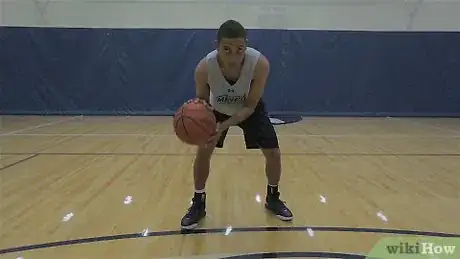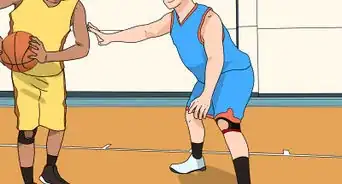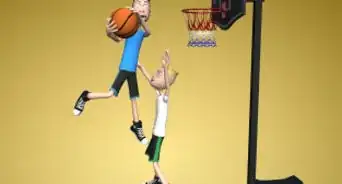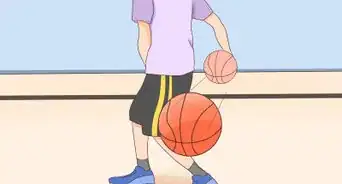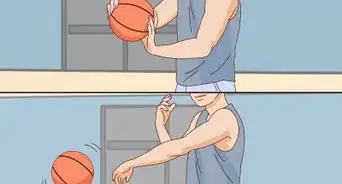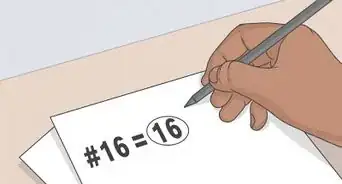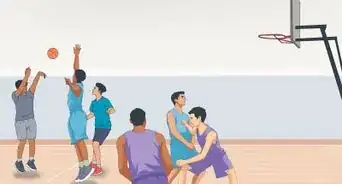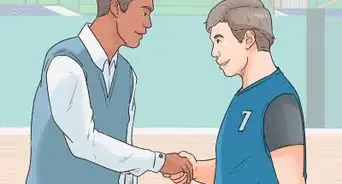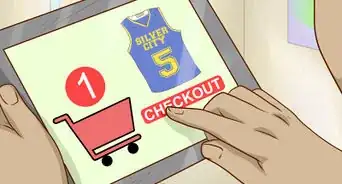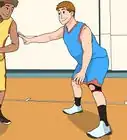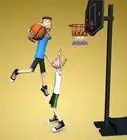This article was co-authored by Ryan Tremblay. Ryan Tremblay is a Basketball Coach and the Owner of National Sports ID and STACK Basketball. With over 30 years of experience, Ryan specializes in basketball coaching, social media marketing, and website design. Ryan created the National Sports ID as a platform to verify the age/grade of youth athletes and STACK Basketball to inspire young athletes to grow into mature individuals and basketball players. Ryan was a First Team All-Decade basketball player in Bergen County and finished in the top 20 all-time leading scorers in the county’s history with 1,730 points. He went on to Caldwell University on a basketball scholarship where he was part of three championship teams. Ryan was a two-time All-Metropolitan, All-State, and All-Conference point guard and the all-time three-point leader in the school’s history, landing him in the Caldwell University Athletic Hall of Fame.
wikiHow marks an article as reader-approved once it receives enough positive feedback. In this case, 82% of readers who voted found the article helpful, earning it our reader-approved status.
This article has been viewed 711,115 times.
When you see an NBA player juke a defender out with a lightning fast between-the-legs, behind-the-back dribble, you're watching the skill of someone with many years of practice. If you're an absolute beginner at basketball, even a basic dribble can be intimidating at first. Luckily, with practice and dedication, anyone can become a better ball handler!
Steps
Learning Dribbling Basics
-
1Touch the ball with your fingertips, not your palm. When you dribble, you want your hands to make contact with the ball in such a way that you have good control over the ball and you don't have to use much arm strength to keep the ball bouncing. For this reason, don't slap the ball with your palm. Rather, try to handle the ball with the tips of your fingers. Spread your fingers out across the surface of the ball for a wider, more balanced contact area.[1]
- Not only will your fingertips give you more control than your palms - you'll also be able to dribble faster. Oklahoma City's player Paul George strongly recommends against palm-to-ball contact, as it "slows down the whole dribbling process."[2]
-
2Get in a low stance. When dribbling, it's not smart to keep an erect, up-and-down posture. In this stance, the ball will have to travel all the way from your upper body to the ground and back again as it bounces, leaving it wide open for a defender to steal. Before you start to dribble, get in a low, defensive stance.[3] Spread your feet shoulder-width apart. Bend your knees and drop your hips back slightly (as if you were sitting in a chair). Get your head up and your upper body mostly erect. This is a good, balanced foundation - it protects the ball while giving you plenty of mobility.[4]
- Don't bend at the waist (as if you were bending over to pick something up). Besides being bad for your back, this stance is fairly unbalanced, meaning it's easier to accidentally stumble forward, which, depending on the in-game situation, can be a big mistake.
Advertisement -
3Bounce the ball off of the ground. This is it! Handling the ball with your fingertips, take it in your dominant hand and bounce it off the ground. Bounce it firmly, but not so hard that you have to use serious arm strength or you have trouble controlling it. Your dribble should be quick, yet steady and controlled. Each time the ball returns to your hand, without grabbing it or catching it in any way, make contact with your fingertips and push it back down with a controlled motion of the wrist and forearm - again, you shouldn't be tiring your arm out from dribbling. The ball should hit the floor at a spot slightly to the side and ahead of the foot that's on the same side of your body as your dribbling hand.[5]
- When you're practicing dribbling for the very first time, it's O.K. to keep your eyes on the ball as you dribble until you get the hang of things. However, you should switch to dribbling without looking at the ball as soon as you can. It's expected that you'll be able to do this at nearly all levels of play.
-
4Keep your hand on top of the ball. When you dribble, it's important to keep the motion of the ball under control. You never want the ball to get away from you, as this can give the other team possession of the ball for free. Try to keep the palm of your hand directly over the ball as you move so that the ball, on its "up" bounce, will bounce right into your fingertips. This will give you more control over the ball as you move around the court.
- Another reason to focus on keeping your hand over the ball at all times while dribbling is that momentarily "catching" the ball on its underside at any point results in a penalty called a carrying violation. To avoid this, keep your palm over the ball and facing the floor as you dribble.
-
5Keep the ball low. The shorter and quicker the ball's bounces, the harder it is for your opponent to steal. One sure-fire way to make your ball's bounces shorter is simply to bounce it closer to the ground. Since you're already in your low stance (with your knees bent and your hips dropped back), it shouldn't feel very unnatural to move the apex of the ball's bounce to somewhere between your knee and hip. Keeping your knees bent, drop your dominant hand down to the side of your leg and dribble with low, quick motions.[6]
- You shouldn't need to bend to the side to dribble in a low stance. If so, you're probably dribbling too low. Remember that, in your low stance, the highest point of your bounce can be up to your hip while still keeping most of the defensive benefits of a low dribble.
Dribbling the Ball around the Court
-
1Keep your head up. When you first start dribbling and the process isn't intuitive yet, it's hard not to look at the ball as you dribble. However, it is very important to practice looking at anything (and everything) else. During a game, you'll have to look for your teammates, keep an eye on your defender, and be aware of where the basket is, all while dribbling. You simply can't do this if you're spending lots of time staring at the ball.[7]
- Serious practice is the only way to get truly confident in your dribbling ability. When you play basketball, you can't waste time focusing on the minutiae of your dribbling technique. Dribbling has to be second nature - you need to be able to "trust" that the ball will return to your hand without watching it.
-
2Be aware of where you dribble the ball. When you're dribbling during a game, the way you dribble the ball should change based on the positions of other players and conditions around you. If you are in open court (such as if you're moving the ball up the court after the opposing team has scored a point), you can dribble ball in front of you, which will let you run as fast as possible. However, when you're near defenders (especially if one's guarding you), bounce the ball at your side (just outside and ahead of your shoe) while assuming a low, defensive stance. This way, the defender will have to reach across your body to get at the ball, having a much harder time reaching it and possibly drawing a foul.
-
3Keep your body between your defender and the ball. When you're being covered by one or more defenders - that is, they're following you and trying to steal the ball and/or block your shots and passes - defend the ball with your body. Never dribble your ball on the same side of your body as the defender is on. Rather, position yourself so that your body is between your defender and the ball, making it difficult for the defender to steal the ball from you (remember - the defender can't just shove you out of the the way or strike across your body to get the ball without risking a foul for his team.).
- You can use the hand that isn't dribbling as an arm bar. Raise your non-dribbling arm and make a fist, presenting the side of your forearm to your opponent. Be careful when using arm bars. Don't push the defender, strike the defender with your fist, or drive through the defender using your arm bar as a wedge. Instead, use an arm bar defensively (like you might hold a shield)[8] to keep space between yourself and the defensive player.
-
4Don't stop. In basketball, offensive players are allowed to start and stop their dribbles only once each time they have the ball. When you're dribbling in a game, don't pick up your dribble unless you know what you're going to do with the basketball. Once you stop, you can't dribble again, and, if s/he is smart, your defender will capitalize on your inability to move.
- If you stop dribbling, your options are to pass the ball, to shoot the ball, or to have the ball stolen from you. If you're planning to do one of the first two, stop dribbling and then do that thing immediately - otherwise, the defense will react and you may have the third option happen whether you like it or not!
-
5Know when to pass the ball. Dribbling isn't always the smartest way to move the ball around the court. Often, it's better to pass. A good passing game is one of the cornerstones of an effective offense. Passing the ball is faster than moving while dribbling, can be used to misdirect the opposing team, and can be used to get the ball to a teammate through a section of the court occupied by defenders. Don't be a ball hog - if dribbling to the hoop means going through multiple defenders, it's usually a good idea to pass the ball to a teammate who has a better chance of making a shot.
-
6Avoid dribbling violations. There are certain basic rules that dictate the way you dribble in basketball. Know these rules! A careless dribbling violation can result in a penalty, halting your team's offensive momentum and giving the defending team the ball for free. Avoid committing any of the following violations:
-
Traveling: Moving with the ball without dribbling. Traveling includes:
- Taking an extra step, skip, hop, or shuffling your feet
- Carrying the ball while you walk or run
- Moving or changing your pivot foot (set foot) when stationary
-
Double dribble: This penalty refers to two separate violations:
- Dribbling with both hands simultaneously
- Dribbling, stopping your dribble (catching or holding the ball), and then starting to dribble again
- Carrying: Catching the ball with one hand and then continuing to dribble (without stopping the dribbling motion). In a carry, your hand makes contact with the bottom of the ball, then flips the ball over in the act of dribbling.
-
Traveling: Moving with the ball without dribbling. Traveling includes:
Learning Advanced Ball Handling Techniques
-
1Practice the "triple threat" stance. The "triple threat" is a highly versatile stance that's taken by offensive players after they receive the ball from a teammate in a pass, but before they start dribbling. From the triple threat position, the player can pass, shoot, or start to dribble. The stance allows the player to protect the ball with his or her hands and body while s/he decides which option to take.[9]
- The triple threat keeps the ball close to the body with the strong hand grasping it on top and the weak hand grasping it on the bottom. The player assumes a low stance and keeps his or her elbows back, bent at ninety degree angles. S/he leans forward over the ball slightly. From this stance, it's very difficult for a defender to steal the ball.
-
2Practice the "crossover" technique. A "crossover" is a dribbling technique used to destabilize and misdirect a defender. The player dribbles the ball in front of his or her body, transferring it between hands in a "V" shape. By "selling" his or her movements, the player can get the defender to move toward the ball while it's in one hand, then quickly cross the ball over to the other hand, allowing the player to quickly dribble around the defender or pass the ball while s/he's off-balance.
- One useful related dribbling technique is the "In & Out Dribble." Essentially, the player pretends that s/he is going to crossover, but keeps the ball in the same hand.
-
3Practice dribbling behind your back. When you're covered by a defender that you just can't shake, you may need to bust out some seriously fancy dribbles. One classic move for "juking" a defender is to dribble behind your back. This move requires serious practice, but it's worth it - when done well, a behind the back move can leave a defender's head spinning.
-
4Practice dribbling between your legs. Another classic ball-handling move is to dribble between your legs. You've probably seen this done by everyone from the Harlem Globetrotters to LeBron James, and for good reason. A quick, well-executed between the legs dribble can flummox even the most difficult defenders.
Expert Q&A
-
QuestionWhy does it feel like I'm not getting better at dribbling?
 Ryan TremblayRyan Tremblay is a Basketball Coach and the Owner of National Sports ID and STACK Basketball. With over 30 years of experience, Ryan specializes in basketball coaching, social media marketing, and website design. Ryan created the National Sports ID as a platform to verify the age/grade of youth athletes and STACK Basketball to inspire young athletes to grow into mature individuals and basketball players. Ryan was a First Team All-Decade basketball player in Bergen County and finished in the top 20 all-time leading scorers in the county’s history with 1,730 points. He went on to Caldwell University on a basketball scholarship where he was part of three championship teams. Ryan was a two-time All-Metropolitan, All-State, and All-Conference point guard and the all-time three-point leader in the school’s history, landing him in the Caldwell University Athletic Hall of Fame.
Ryan TremblayRyan Tremblay is a Basketball Coach and the Owner of National Sports ID and STACK Basketball. With over 30 years of experience, Ryan specializes in basketball coaching, social media marketing, and website design. Ryan created the National Sports ID as a platform to verify the age/grade of youth athletes and STACK Basketball to inspire young athletes to grow into mature individuals and basketball players. Ryan was a First Team All-Decade basketball player in Bergen County and finished in the top 20 all-time leading scorers in the county’s history with 1,730 points. He went on to Caldwell University on a basketball scholarship where he was part of three championship teams. Ryan was a two-time All-Metropolitan, All-State, and All-Conference point guard and the all-time three-point leader in the school’s history, landing him in the Caldwell University Athletic Hall of Fame.
Basketball Coach Make sure that you're putting in plenty of practice time. Dribbling isn't something you do once in a while—it's something you have to practice all the time.
Make sure that you're putting in plenty of practice time. Dribbling isn't something you do once in a while—it's something you have to practice all the time. -
QuestionHow can I learn to dribble a basketball between my legs?
 Ryan TremblayRyan Tremblay is a Basketball Coach and the Owner of National Sports ID and STACK Basketball. With over 30 years of experience, Ryan specializes in basketball coaching, social media marketing, and website design. Ryan created the National Sports ID as a platform to verify the age/grade of youth athletes and STACK Basketball to inspire young athletes to grow into mature individuals and basketball players. Ryan was a First Team All-Decade basketball player in Bergen County and finished in the top 20 all-time leading scorers in the county’s history with 1,730 points. He went on to Caldwell University on a basketball scholarship where he was part of three championship teams. Ryan was a two-time All-Metropolitan, All-State, and All-Conference point guard and the all-time three-point leader in the school’s history, landing him in the Caldwell University Athletic Hall of Fame.
Ryan TremblayRyan Tremblay is a Basketball Coach and the Owner of National Sports ID and STACK Basketball. With over 30 years of experience, Ryan specializes in basketball coaching, social media marketing, and website design. Ryan created the National Sports ID as a platform to verify the age/grade of youth athletes and STACK Basketball to inspire young athletes to grow into mature individuals and basketball players. Ryan was a First Team All-Decade basketball player in Bergen County and finished in the top 20 all-time leading scorers in the county’s history with 1,730 points. He went on to Caldwell University on a basketball scholarship where he was part of three championship teams. Ryan was a two-time All-Metropolitan, All-State, and All-Conference point guard and the all-time three-point leader in the school’s history, landing him in the Caldwell University Athletic Hall of Fame.
Basketball Coach Just like with anything else, you've got to practice a lot. Try doing it 50 times from left to right, then 50 times from right to left, and just keep coming up with different combinations and doing it over and over again. I think the best way to do it is to have sets—maybe do 5 sets of 10 or 5 sets of 20 over and over, and try to do that for 30 minutes to an hour, just focused on going through the legs. That's the type of work that it takes.
Just like with anything else, you've got to practice a lot. Try doing it 50 times from left to right, then 50 times from right to left, and just keep coming up with different combinations and doing it over and over again. I think the best way to do it is to have sets—maybe do 5 sets of 10 or 5 sets of 20 over and over, and try to do that for 30 minutes to an hour, just focused on going through the legs. That's the type of work that it takes. -
QuestionWhat exercises will help me get better at dribbling?
 Ryan TremblayRyan Tremblay is a Basketball Coach and the Owner of National Sports ID and STACK Basketball. With over 30 years of experience, Ryan specializes in basketball coaching, social media marketing, and website design. Ryan created the National Sports ID as a platform to verify the age/grade of youth athletes and STACK Basketball to inspire young athletes to grow into mature individuals and basketball players. Ryan was a First Team All-Decade basketball player in Bergen County and finished in the top 20 all-time leading scorers in the county’s history with 1,730 points. He went on to Caldwell University on a basketball scholarship where he was part of three championship teams. Ryan was a two-time All-Metropolitan, All-State, and All-Conference point guard and the all-time three-point leader in the school’s history, landing him in the Caldwell University Athletic Hall of Fame.
Ryan TremblayRyan Tremblay is a Basketball Coach and the Owner of National Sports ID and STACK Basketball. With over 30 years of experience, Ryan specializes in basketball coaching, social media marketing, and website design. Ryan created the National Sports ID as a platform to verify the age/grade of youth athletes and STACK Basketball to inspire young athletes to grow into mature individuals and basketball players. Ryan was a First Team All-Decade basketball player in Bergen County and finished in the top 20 all-time leading scorers in the county’s history with 1,730 points. He went on to Caldwell University on a basketball scholarship where he was part of three championship teams. Ryan was a two-time All-Metropolitan, All-State, and All-Conference point guard and the all-time three-point leader in the school’s history, landing him in the Caldwell University Athletic Hall of Fame.
Basketball Coach The biggest thing is just to do it over and over—practice makes perfect. Dribbling is all about the rhythm that's involved. Also, dribbling two balls while you're standing in one spot is a great way to build up both hands at the same time.
The biggest thing is just to do it over and over—practice makes perfect. Dribbling is all about the rhythm that's involved. Also, dribbling two balls while you're standing in one spot is a great way to build up both hands at the same time.
References
- ↑ https://www.youtube.com/watch?v=6lJN5uC90Zk
- ↑ https://www.youtube.com/watch?v=HmlJjskzjuo
- ↑ Ryan Tremblay. Basketball Coach. Expert Interview. 9 March 2021.
- ↑ https://www.basketballforcoaches.com/how-to-dribble-a-basketball/
- ↑ https://www.youtube.com/watch?v=6lJN5uC90Zk
- ↑ Ryan Tremblay. Basketball Coach. Expert Interview. 9 March 2021.
- ↑ https://www.basketballforcoaches.com/how-to-dribble-a-basketball/
- ↑ https://www.youtube.com/watch?v=ZNM8e4qReno
- ↑ Ryan Tremblay. Basketball Coach. Expert Interview. 9 March 2021.
About This Article
To dribble a basketball, hold the ball so that your fingertips are the only part of your hand that’s touching the ball, place your legs about shoulder-width apart, and bend your knees slightly. Bounce the ball off the ground firmly and use your fingertips to catch it as it bounces up before pushing it to the ground again. To dribble as you walk, step so that one of your feet always hits the ground with the ball. Keep the ball 3 inches away from the side of your body and low to the ground while you move. For more tips, including dribbling drills, read on!
